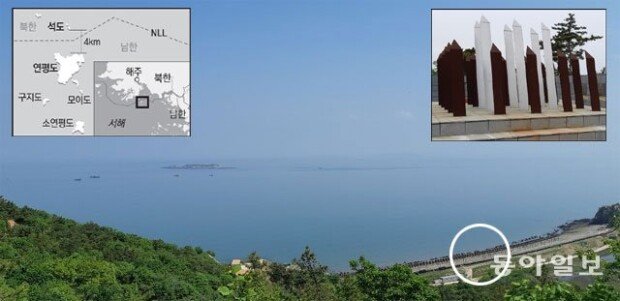'Tears of Yeonpyeongdo' Half a flash of light only
'Tears of Yeonpyeongdo' Half a flash of light only
Posted May. 22, 2019 08:00,
Updated May. 22, 2019 08:00

“What did we do wrong to put a shade on the lighthouse?” This was my first impression of the lighthouse at Yeonpyeong Island relighted after 45 years on May 17 at 7:20 p.m. It was not like any typical lighthouse that stands tall and rotates 360 degrees to guide sailors their way back home. Although the lighthouse is located at an altitude of 105 meters, shining a light far out to the sea, it only flashes a light towards the south as half of the lamp is covered with a shade. The lighthouse at Yeonpyeong Island represents incomplete reconciliation between two Koreas and the tensions surrounding the border islands in the West Sea.
The border islands in the West Sea, such as Baengnyeong and Yeonpyeong Islands are located north of 38th parallel but were incorporated into the Ongjin County, Gyeonggi Province according to the ceasefire agreement signed after the end of the Korean War. There is only a 10 km distance between the northern end of Yeonpyeong Island and Ongjin County, North Korea. Some of the residents at the border islands, which have a combined population of about 2,300, were born in North Korea.
The lighthouse at Yeonpyeong Island was relighted thanks to the friendly atmosphere between the two Koreas created after the April 2018 inter-Korean summit and the September 19 Military Agreement. On the day of the relighting ceremony, Cheong Wa Dae announced that it would push ahead with a plan to send 8 million dollars to North Korea as a humanitarian effort. On the same day, the government approved business owners, who have operated at the Kaesong Industrial Complex, to visit North Korea to inspect their assets in three years since the shutdown. But the Rodong Sinmun of North Korea on May 19 called the humanitarian assistance “a move to give one and take ten,” denying a helping hand. It feels futile to support North Korea as if the lighthouse at Yeonpyeong Island shines a light towards the sea that never answers back.
North Korea’s attack on the border island of Yeonpyeong on November 23, 2010 killed two South Korean soldiers and two civilians. It was North Korea’s first bombardment of South Korean territory since the end of the Korean War. At 172 Yeonpyeong-ri, one of the residential areas that were hit by the nonselective bombing stands a security training center. Three houses that lost a roof to a bombing and have been blackened with fire are left as they are. By those houses stand the 122-mm multiple rocket launchers collected from the scene.
Those destructed houses might bring back the horrific memories of that day. “One can recover from trauma more easily if he or she is exposed to the very site where the incident took place. So I recommend the residents to come and see the houses more often. But there are some people who still have not visited the scene. They are still in such a great shock,” said Kim Myung-sun from the district office. “The impact of the bombing crushed the gate and shattered the glasses. I don’t think I can stay on the island if something like that happens again,” said a hostess at a B&B.
Relighting of the lighthouse has sparked security concerns as well. Although there is a shade on the lamp, it could help non-powered vessels from North Korea to approach South Korean land. “It could put us in danger and help North Korea hold the residents as a hostage,” a resident surnamed Cha said at the relighting ceremony. “We patrolled around the island several times with the light on to study the impact of the lighthouse on operations and found no issues,” said an official of a troop stationed at the island.
South Korean troops halted live-fire artillery drills on the island after the Yeonpyeong Island attack. Some argued that the South should act tough and carry out more drills as the attack followed a South Korean artillery exercise on the island. Halting artillery drills could be seen as giving in to the threats by North Korea. But many residents said they are glad that they do not have to hear the deafening sound coming from the artillery drills. “We increased the number of shooting exercises we carry out on the land,” a military official said.
The residents have been asking the government to relight the lighthouse for their nighttime fishing operation. But they are still unhappy about the hours they are allowed to operate. Currently the nighttime operating hours are 30 minutes after the sunset and 30 minutes before the sunrise. Fishing operation is prohibited near the border islands in the West Sea from sunset to sunrise in order to prevent fishing boats from approaching the northern limit line (NLL) or being captured by North Korea.
Some residents complain about not easing the control near the NLL when trails have been built along the ceasefire line on the land. They are particularly furious at Chinese fishing boats illegally catching fish near the NLL.
Chinese fishing boats sail towards the south of NLL at night and operate illegally. A few years ago, the West Sea was crowded with more than 100 Chinese fishing boats. Thanks to the efforts by the special coast guard created two years ago, the number of Chinese fishing boats in our territorial waters has been reduced. A fundamental solution to stop Chinese fishing boats from operating illegally would be setting up a common fishing ground for South Korea and China. But the chances are unlikely.
“The boat promised to come back with lots of yellow corvina/ Why hasn’t it come back yet?/…Painting the boat on the sunset beach/ I only see flashing lighthouse. Tears in Yeonpyeong Island.” When the ferry bound for Incheon arrives at the dock on the island, one will see a memorial stone with the lyrics of “Tears in Yeonpyeong Island” beside the terminal. The lyrics are about the damage caused by the typhoon Sarah in 1959, when greater damage was done due to lack of broadcast and communication. Leaving the island, this reporter looked at it once again from the ferry. The island already suffering from the threats from North Korea and illegal fishing activities by China should not be hurt again by our indifference.
Ja-Ryong Koo bonhong@donga.com
Headline News
- Med professors announce intention to leave hospitals starting Thursday
- Bridge honoring Sgt. Moon Jae-sik unveiled in Pennsylvania
- Chief of Staff Chung tells presidential secretaries to stay away from politics
- US FTC bans noncompete agreements
- N. Korea launches cyberattacks on S. Korea's defense companies







